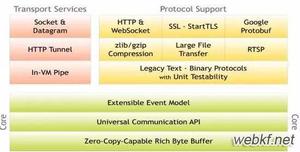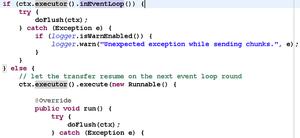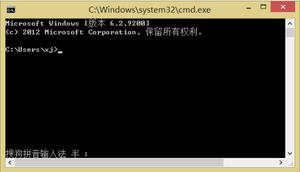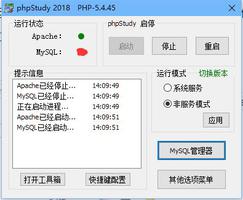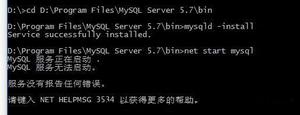Netty 服务端启动流程-I
简介
Netty的主从Reactor多线程模型,通常都会创建两个EventLoopGroup,分别作为主从线程池:
bossGroup:主要处理accept事件,之后将建立的客户端连接注册到workerGroup
workerGroup:负责处理I/O事件
Netty服务端的启动流程:
- 初始化EventLoopGroup
- 创建服务端启动器-ServerBootStrap
- 绑定监听端口,并等待绑定完成
- 阻塞主线程,保持服务端的启动
I-EventLoopGrouop的初始化
图示:
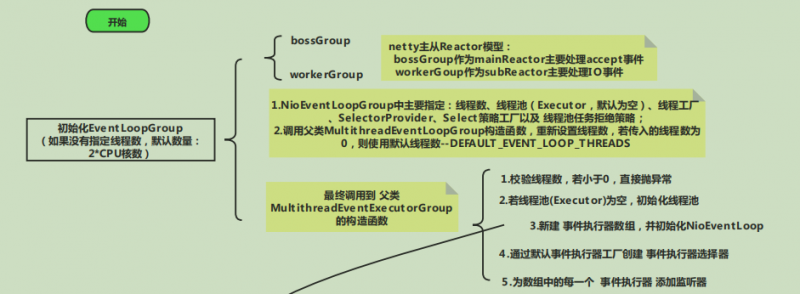
// 如果 不指定线程数,将使用默认线程数:2倍的CPU核数EventLoopGroup bossGroup = new NioEventLoopGroup();
EventLoopGroup workerGroup = new NioEventLoopGroup();
主要类调用:
NioEventLoopGroup
-->MultithreadEventLoopGroup
-->MultithreadEventExecutorGroup
NioEventLoopGroup
其构造方法主要调用父类MultithreadEventLoopGroup的构造方法
// 默认的 构造方法,在这里 默认指定了 线程数0public NioEventLoopGroup() {
this(0);
}
// 最终调用的 构造方法
public NioEventLoopGroup(int nThreads, Executor executor,
final SelectorProvider selectorProvider,
final SelectStrategyFactory selectStrategyFactory) {
// 调用父类构造方法 传递了各种参数
super(nThreads, executor, selectorProvider, selectStrategyFactory,
RejectedExecutionHandlers.reject());
}
nThreads:线程数
executor: JDK的executor(线程池,用来创建线程),默认为null
selectorProvider: SelectorProvider, 用来打开一个 Selector
selectStrategyFactory: Select 策略工厂,默认为DefaultSelectStrategyFactory.INSTANCE
rejectedExecutionHandlers:任务拒绝处理器
MultithreadEventLoopGroup
其构造方法主要调用父类MultithreadEventLoopGroup的构造方法,在这个类中指定了默认线程数;如果传入的线程数为0,则使用默认线程数
// 构造方法,重新指定 线程数protected MultithreadEventLoopGroup(int nThreads, Executor executor, Object... args) {
// 直接调用 父类构造方法
super(nThreads == 0 ? DEFAULT_EVENT_LOOP_THREADS : nThreads, executor, args);
}
// 默认线程数
private static final int DEFAULT_EVENT_LOOP_THREADS;
// 静态初始化
// 1.先获取配置io.netty.eventLoopThreads 指定的线程数
// 2.如果没有获取到,则返回传入的默认值 NettyRuntime.availableProcessors() * 2)
static {
DEFAULT_EVENT_LOOP_THREADS = Math.max(1, SystemPropertyUtil.getInt(
"io.netty.eventLoopThreads", NettyRuntime.availableProcessors() * 2));
if (logger.isDebugEnabled()) {
logger.debug("-Dio.netty.eventLoopThreads: {}", DEFAULT_EVENT_LOOP_THREADS);
}
}
MultithreadEventExecutorGroup
在这个类中,完成了EventLoopGroup以及EventLoop的初始化流程。但EventLoop还并为启动;
protected MultithreadEventExecutorGroup(int nThreads, Executor executor,Object... args) {
// 调用 本类构造方法;传递了 事件执行器选择器工厂
this(nThreads, executor, DefaultEventExecutorChooserFactory.INSTANCE, args);
}
最终调用的构造方法,来开始初始化EventLoopGroup,主要流程:
- 校验executor,如果为null,初始化一个线程池Executor
- 新建EventExecutor数组,大小为 nThreads
- 初始化 每一个EventExecutor,这里用到了NioEventLoopGroup中的newChild方法
- 根据 EventExecutor数组的大小,使用事件执行器选择器工厂初始化事件执行器选择器
- 为每一个EventExecutor 添加终结监听器,只有全部的EventExecutor关闭了,才算关闭成功
protected MultithreadEventExecutorGroup(int nThreads, Executor executor,EventExecutorChooserFactory chooserFactory, Object... args) {
if (nThreads <= 0) {
throw new IllegalArgumentException(String.format("nThreads: %d (expected: > 0)", nThreads));
}
// step 1
if (executor == null) {
executor = new ThreadPerTaskExecutor(newDefaultThreadFactory());
}
// step 2
children = new EventExecutor[nThreads];
for (int i = 0; i < nThreads; i ++) {
boolean success = false;
try {
// step 3
children[i] = newChild(executor, args);
success = true;
} catch (Exception e) {
// TODO: Think about if this is a good exception type
throw new IllegalStateException("failed to create a child event loop", e);
} finally {
// 如果有一个没有创建成功,则关闭之前所有成功创建的EventLoop
if (!success) {
for (int j = 0; j < i; j ++) {
children[j].shutdownGracefully();
}
for (int j = 0; j < i; j ++) {
EventExecutor e = children[j];
try {
while (!e.isTerminated()) {
e.awaitTermination(Integer.MAX_VALUE,TimeUnit.SECONDS);
}
} catch (InterruptedException interrupted) {
// Let the caller handle the interruption.
Thread.currentThread().interrupt();
break;
}
}
}
}
}
// step 4
chooser = chooserFactory.newChooser(children);
// 创建 监听器
final FutureListener<Object> terminationListener = new FutureListener<Object>() {
@Override
public void operationComplete(Future<Object> future) throws Exception {
if (terminatedChildren.incrementAndGet() == children.length) {
terminationFuture.setSuccess(null);
}
}
};
// step 5
for (EventExecutor e: children) {
e.terminationFuture().addListener(terminationListener);
}
// 设置 只读
Set<EventExecutor> childrenSet = new LinkedHashSet<EventExecutor>(children.length);
Collections.addAll(childrenSet, children);
readonlyChildren = Collections.unmodifiableSet(childrenSet);
}
newChild方法
调用的 NioEventLoopGroup类中的newChild方法,初始化EventLoop,也就是NioEventLoop
以上是 Netty 服务端启动流程-I 的全部内容, 来源链接: utcz.com/a/26389.html

